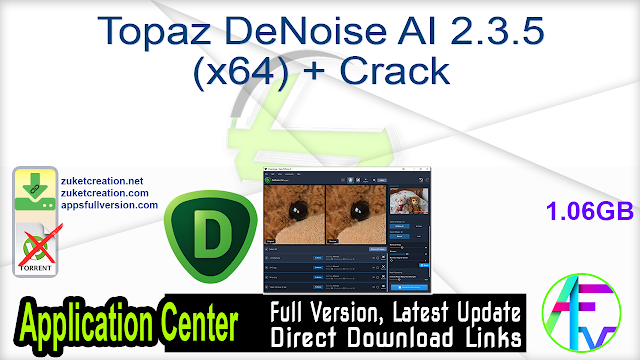
TOPAZ DENOISE FOR IPAD 720P
It is simply impossible to invent real detail convincingly, though uprezzing from 720p and FHD to 4K can be much more successful. BCC Uprez is also quite good, at least as good as Topaz, in my experience and has the advantage of working directly within an NLE.Įven if you look at the examples on Topaz's website, they are not very convincing and presumably they were the best showcases. Professionally Teranex is still used for this type of work, more often but I cannot justify the cost for this one show.

Also at the time I had a JVC HD101E (one of the first in Europe), that could shoot progressive DV and this is much sharper footage to uprez, even though the camera was somewhat cheaper than the Sony. At the time I had very careful settings that reduced edge sharpening to a minimum, so fortunately that is not a huge problem. This series, was shot by me, on a broadcast DSR570 with J11 and J17 top quality lenses. Then de-interlacing is performed and Neat Video has an excellent sharpening filter, as well as denoising and removing macro blocking.


The deck has a very good HDMI out that upscales the footage to HD (1080i), quite capably. The best solution I found is to recapture the DVCam tapes (I still have them) via a JVC HDV deck through Utlrastudio Mini 4K, to Avid.
TOPAZ DENOISE FOR IPAD FULL
VEIA is better otpimized for Nvidia (actually i use it under win with nvidia old and under mac with Amd vega 64, and old nvidia 980ti go more faster than Vega).Ĭarlomacchiavello wrote:A full solution on long time tv series is a very complex task, i know that is a very time consuming task.
TOPAZ DENOISE FOR IPAD WINDOWS
Topaz unfortunately is not a fast solution, i tried many times every AI solution that i founded, Gain based and more, but also if faster, i not founded better solution for some problems like edge sharpening of old analog / low res cam or to deinterlace in the good way.Īnd often i should composite different version to have the best, but i'm enough lucky to do on short sequence, and i had time to do that.Ī full solution on long time tv series is a very complex task, i know that is a very time consuming task.Ī possible solution (i not tested) under windows is to run by command line interface more task at same time on different GPU Nvidia, it's not avaible for all, it's in new betas of 3.0, i will test it in future, i had a windows computer with three nvidia for 3d rendering and for intensive denoise by neatvideo. As I mentioned a very fine filmlike grain is really quite nice, it starts to look like 16mm. But I will follow your suggestions for some tests. My TV series is 5 hours! And so to run it all through Topaz would be an ordeal. There was a thread here where I submitted stills, but nobody provided a better solution than I can get myself, even though they recommended a very complex method. I am currently, in between working for a living, restoring an old TV series I made around 2006, shot in DVCam. You can see that very often on 4K Netflix documentaries that incorporate DV archive. Steve Fishwick wrote:Yes Carlo, it's true, it has some very innovative tools, I should experiment more with it However as I say, it's often a time/workflow issue and I have never seen an ideal solution for SD DV interlaced footage. Because, for me, as I said the difference between this and what can be achieved directly in the NLE, is subtle, I prefer to choose the quickest workflow, consistent with some useful improvement, but obviously YMMV. Grain often helps with perceptual sharpness in images.

Most of it ends up looking like severe edge enhancement from the old video camera days, which is beginning to happen, I would say, in Carlo's first two examples too.įor DV footage, the best solution I have found is de-interlacing, judicious uprez to HD (4K is not going to happen) and then a very mild filmlike grain applied. It's easy to make an image very plastic looking with these tools. But nothing is really a magic bullet, and as with de-noising less is almost always better than more, the difference between results from all methods are subtle rather then dramatic. It's perhaps best for uprezzing BMD HD slo mo shots to 4K. I bought Topaz on an offer that was going but I hardly use it, since the workflow is cumbersome and slow. Ellory Yu wrote:I kind of expected anything that does “aI” is calculation intensive and reiterative in its algorithm.ĪI is almost a misnomer these days, at least I would say it's not nearly as intelligent as the marketing would suggest, as you can see from Carlo's third example.


 0 kommentar(er)
0 kommentar(er)
